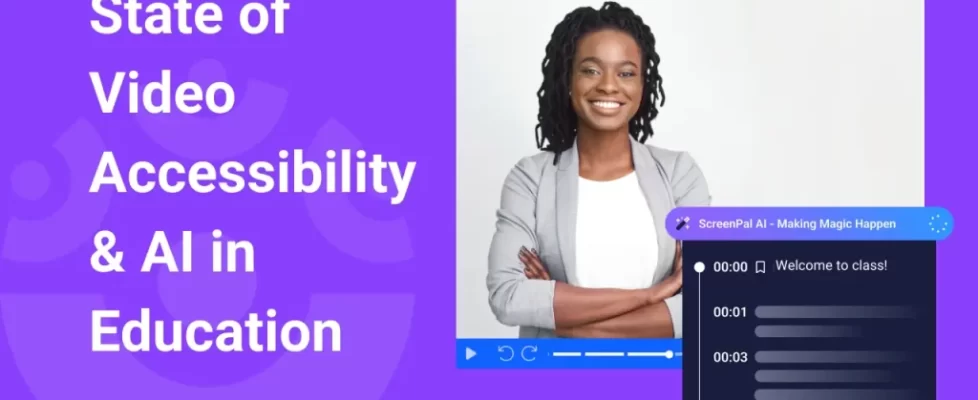We live in a world of shrinking attention spans. While this may not be a big problem among adults, educators are having a tough time grabbing and keeping their students’ attention.
People have gotten used to quick content consumption thanks to the growing popularity of short-form video content. But what can you do when you have to make your students sit through long lessons?
One of the most effective ways to achieve that is by using interactive tools.
This article will examine ten interesting teaching tools that can help you keep your students’ attention against all odds. We’ll also share some tools that will make your life as an educator a little easier.
TL:DR; Best online teaching software for educators
Here are the key highlights of this article:
- Online teaching tools are designed to help you create more engaging lessons through interactive videos and elements like quizzes and polls.
- Pick an easy-to-use tool compatible with your existing edtech toolset.
- Some of the top teaching tools are ScreenPal for engaging video lessons, Blooket for gamified assessments, Parlay for classroom discussions, Nearpod for interactive discussions, and ClassDojo for classroom engagement.
What to look for when picking teaching tools
Choosing the right tool can make a significant difference in the effectiveness of your lessons. Here is the criterion to follow when picking the tools:
A. Ease of use
The best teaching tools will make your life easier and not add extra complexities. As such, you must pick tools that are intuitive and easy to use for both you and your students.
Ease of use is especially critical if you expect your students to interact with the tool. Consider your student’s skill level and pick a tool they’ll find easy to use.
B. Compatibility with other tools
Chances are you’re already using other tools in your class. So, before investing in additional teaching software, confirm that any new tool is compatible with your existing apps.
Seamless integration makes it easier to move between the tools and enhances the overall learning experience.
C. Cost
Finally, you must pick a tool that gives you the most value without breaking the bank.
The truth is that you’re working with a limited budget. But that should not push you into going for the cheapest option. Instead, look for a tool that supports all the essential functionalities at the most reasonable price.
10 best online teaching tools for educators
Let’s now look at the top online teacher tools for educators:
1. ScreenPal – For engaging video lessons
ScreenPal is the perfect tool for creating engaging video lessons for your students. ScreenPal for educators combines several tools that help you create, edit, and share custom videos from one platform.
You have the free screen recorder, for example. This one lets you capture the screen of your Windows, Mac, Android, or iOS device. It also supports both Chromebooks and iPads.
Besides recording your screen, you can capture microphone audio and add video from your webcam. That makes it a great tool for creating engaging instructional videos. And it achieves all that without including any watermarks on your videos.
The best part about ScreenPal is that it allows you to create interactive teaching videos. You can include elements like quizzes within the video, which ensures students are actively involved throughout the lessons. The quizzes also help you gauge student understanding of each lesson.

The platform also ensures accessibility for all learners through automated speech-to-text captions.

ScreenPal gives you detailed analytics of each video. You can see how many people watched your instructional videos, heatmaps, rewatches, and skipped content. You’ll also get insights from your quizzes.

This makes ScreenPal the ultimate teaching tool for creating video lessons! Educators can even get the students to make their own videos with the platform, putting them on a path to creativity and content creation.
Plus, it is COPPA and FERPA-compliant and protects student data and privacy.
ScreenPal is compatible with Moodle, Google Classroom, Blackboard, Microsoft Teams, Zoom, Canvas, and Brightspace.
2. Blooket – For gamified assessments
Blooket is an incredibly effective class engagement platform. Instead of letting your students learn from oversized textbooks, the platform gamifies the learning experience to ensure students pick up on the key concepts without even noticing it!
This is achieved through different online games you can customize to meet your student’s unique learning needs. The students are also kept motivated through in-game rewards.
How it works
First, the host or educator creates a set of questions. You can make these questions from scratch within the platform or import them from somewhere else through Blooket’s converter tools.

The platform also has a Discover database where you can find relevant questions you can use for your lessons.

Once the questions are ready, the next step is to pick a game mode. The platform offers different game modes to keep students engaged.
After picking the game mode, it’s now time to host the game and invite your students. You’ll host the game on a big screen, and then Blooket will provide a game ID you can share with your students. The students will join in with the ID and participate in the game.
Students can then proceed to play the game while answering the different questions. This ensures that the students are engaged while also getting quizzed on their knowledge.
Finally, you’ll receive a detailed report showing how your students performed. This helps you pinpoint concepts or areas where you need to improve.
3. Parlay – Track how classroom discussions develop
Parlay promises to transform classroom discussions through various tools, including roundtable discussions and AI-guided discussion suggestions.
It also provides an extensive library of discussion topics and subjects used by other educators in the community.
How it works
Parlay gives you two distinct roundtables: a written and verbal roundtable. The written roundtable lets you create a threaded discussion where one person can post something, and the rest contribute through comments.

Meanwhile, the verbal roundtable gives your students a voice by allowing them to speak their minds. Both options make it really easy for you to track student participation.

This platform also uses AI to help you create and facilitate meaningful, engaging classroom discussions.
The AI tool (Parlay Genie) can go through your discussions, read articles, and analyze videos. It then uses the insights from that content to create follow-up questions or suggest additional discussions.
Parlay integrates with over 20 learning management systems (LMS). The platform also provides an admin portal/dashboard. You can track usage from this dashboard. It also lets you add and delete coaches/educators.
4. Quizizz – For student-paced and instructor-paced quizzes
Quizizz is an online learning platform that allows educators to deliver interactive lessons, quizzes, and assignments.
The platform uses gamification elements like avatars and leaderboards to keep the students engaged.
How it works
Quizizz lets you create assessments and lessons for different content areas. It accommodates math, ELA, Science, Social Studies, and world languages.
You can also choose to create content based on specific objectives. For example, you can focus on SEL, EduProtocols, State Test Prep, Elementary, ELLS, and ESOL.
Whatever path you choose, you’ll gain access to a vast selection of question types and flexible grading.
The “Show Your Work” feature also ensures your students can share how they ended up with particular answers.

And, of course, the platform gives you tons of data to track student performance and progress.
5. Nearpod – For interactive discussions
Nearpod is an interactive instructional delivery platform. The software has a vast library of over 22,000 lessons and videos created by curriculum experts.
According to their 2023 report, 92% of educators on Nearpod report that the platform increased student engagement. Another 87% said it improved in-person instructional experience.
How it works
Nearpod lets you upload your own educational resources or pick learning materials from their extensive library.

You can then customize the lesson’s dynamic media and formative assessments. It also lets you test your students’ understanding with open-ended questions, polls, Draw It, phET Simulations, and VR Field Trips.
The platform delivers actionable data from the assessments to guide your lessons. Use this data to pinpoint lessons your students have not mastered.
Another great thing about Nearpod is it lets you customize the learning experience. You can use the Student-Paced option to customize each lesson to a specific student or group.
You can also control the learning pace by letting your students participate with video conferencing or on their own devices. There’s also the option of watching a video lesson as a class.
6. ClassDojo – For classroom management
ClassDogo is a free classroom management platform. The software connects students, teachers, and parents, allowing them to exchange different kinds of messages.
For example, teachers can post stories similar to the ones on social media. These stories help parents see what’s happening inside classrooms. The images and videos are shared through a private feed so only the parents can see them.
ClassDojo also allows you to create a shared calendar where you can add events and have them shared with all the parents automatically.
How it works
In addition to the above features, ClassDojo gives educators a teacher toolkit. This kit allows you to create attendance sheets, timers, groups, and more.

The platform also integrates with Google Classroom to help you engage the students and communicate with families.
7. Curipod – Create interactive lessons
Curpod drives student engagement by allowing educators to create gamified and story-based lessons. Perhaps the best part is that you’ll receive real-time AI feedback to know just how effective your lessons are.
How it works
Curipod lets you customize lessons with your own rubric. It also allows you to access and customize state test prep lessons for all 50 states.

The School & District package supports downloading lessons for offline access.
8. Remind – Connect students, teachers, and parents
Remind is a communication platform that allows teachers to stay in touch with families and students wherever they are. It supports a two-way chat between teachers and families with automatic translation of over 90 languages.
There’s also the hub where educators can share information on specific classes, the school, or the district.
How it works
Remind has a powerful administrator dashboard where you can oversee all communications. The dashboard tells you who is communicating and how often they are communicating. It also gives you oversight over all communications to ensure they remain safe and friendly.

You can monitor attendance through Remind and send time-sensitive messages via text. That means families don’t need smartphones to stay connected with the educators.
9. Planboard – For effective lesson planning
Planboard is a great lesson planner designed for teachers on the go. This mobile app organizes your subjects, lessons, and the entire semester in a beautiful dashboard.
Planboard allows you to share your lessons conveniently from your smartphone using Google Classroom and Schoology Learning.
The platform supports attachments, letting you attach a lesson to any announcement, question, or assignment. Moreover, it connects lessons with standards, which helps you see the progress of each class.
Planboard supports all major standards, including the Canadian provincial standards, US state standards, and international standards, among others.
10. Padlet – Virtual whiteboard for collaboration
Padlet provides beautiful boards and canvases to facilitate visually engaging collaborations. You can use these canvases to share ideas, create lessons, and organize class activities.

How it works
Every board on Padlet starts as a blank canvas to which you can add text, images, or videos. For instance, you could use a tool like the Axios HQ free paraphraser to summarize a lesson into key highlights and use the highlights to create stunning slides for your lessons. You can also customize the board to give it the perfect look and feel for the goal you have in mind.
The next step is to share the board with others. These folks can be collaborators, meaning they can add more content to the board. For example, you can invite students to collaborate by adding more images and videos.

Users can also collaborate through comments, likes, and votes.
Padlet integrates with LMS and most learning tools, including Blackbaud, Moodle, Microsoft Teams, Canvas, Google Classroom, and Schoology.
Wrapping Up
The age of browsing through massive textbooks is behind us. Technology has brought about incredible online tools that promise to keep modern students engaged while boosting their performance.
Not only that, but these tools have also made life much easier for educators. With real-time feedback and detailed analytics, you can quickly tell which students are falling behind or the lessons that require a second look.
This article has shared ten incredible apps to add to your teaching toolset. Consider your needs and pick the right solutions for you and your students.
Author Bio
Nicholas is the founder of Free Domain Name Generator. He runs a marketing agency and provides SEO services to customers across various niches. He spends his spare time traveling with his partner.


































